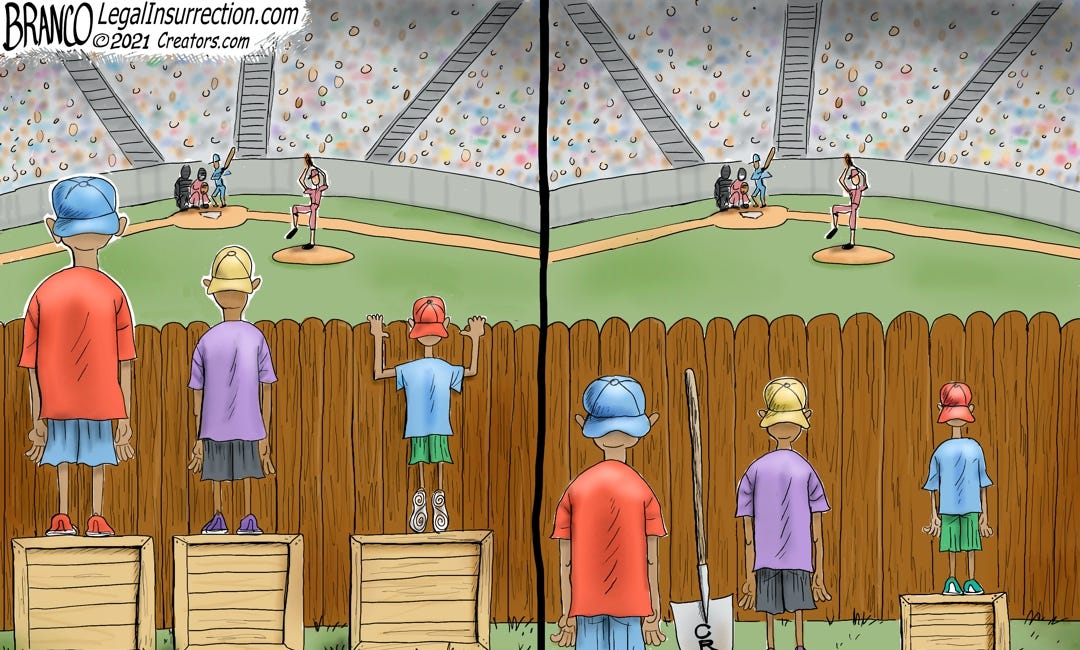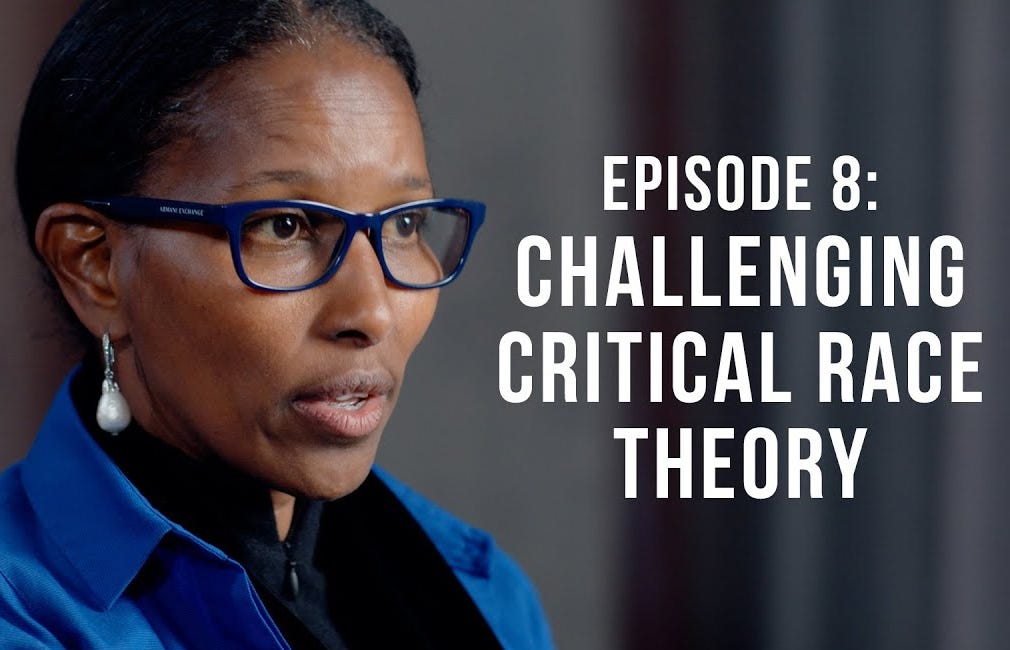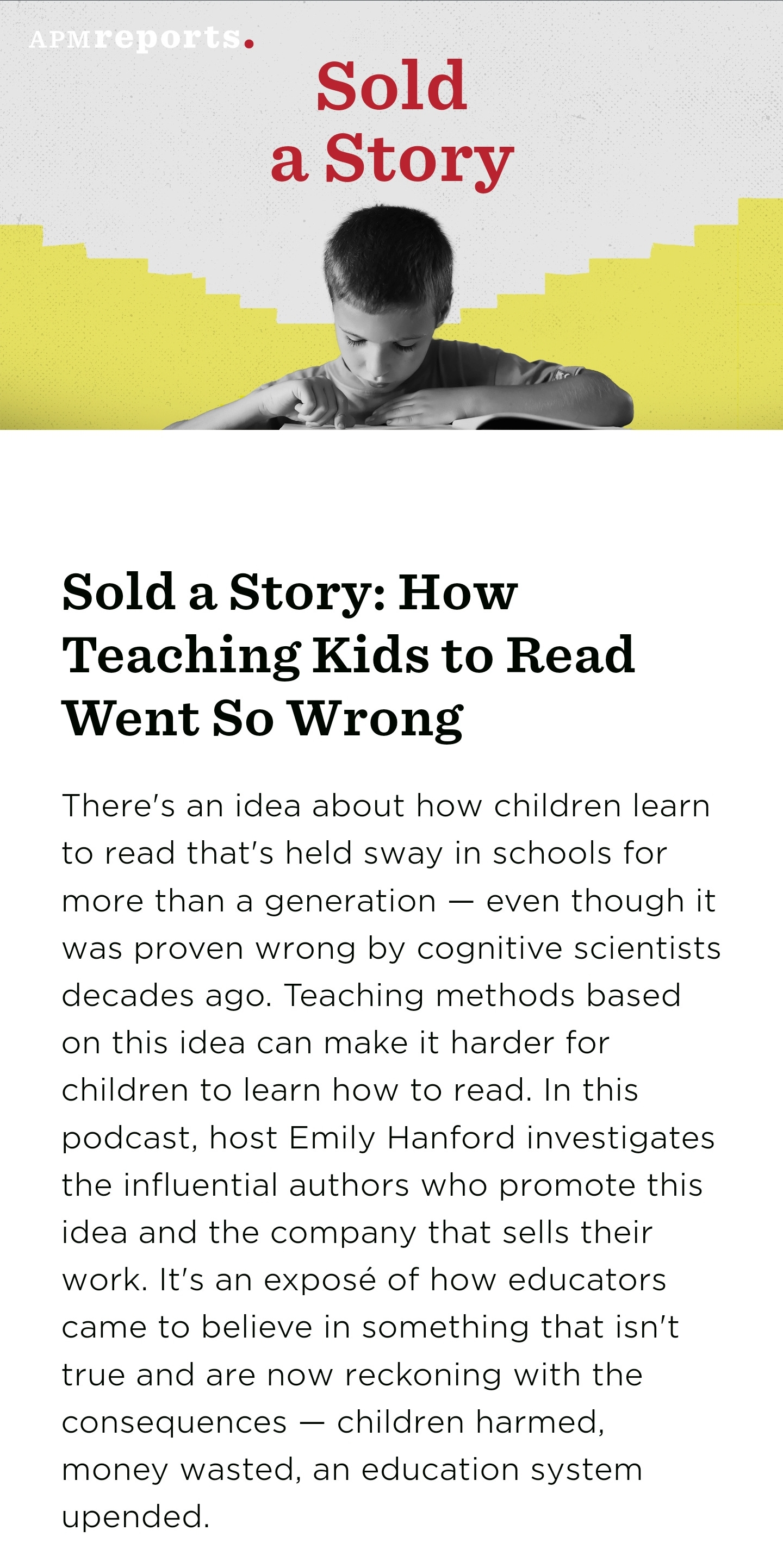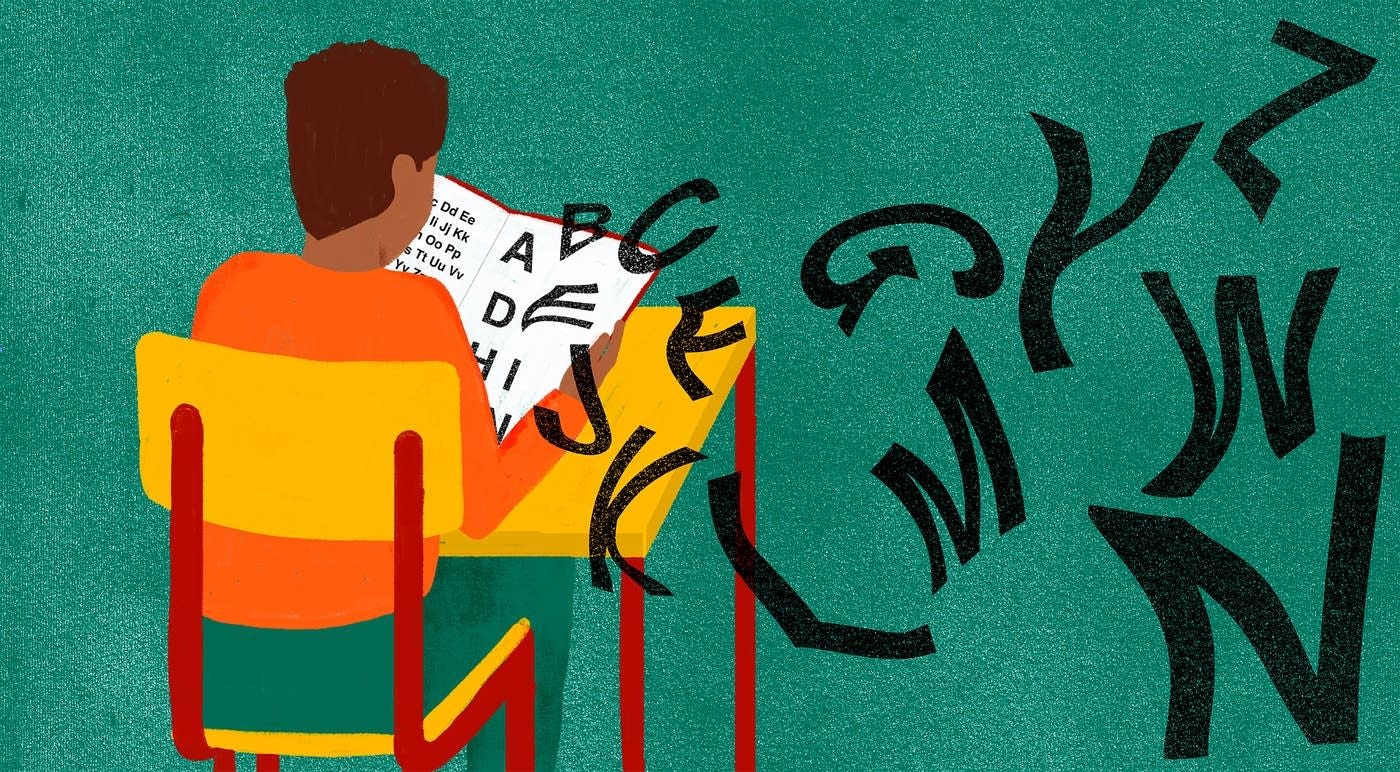Sold a Story: Misreading the Cues
What can be more of a barrier than denying a child literacy
This article continues in Thomas Sowell, McGuffey, and Eliminating Dogmas
There's an idea about how children learn to read that's held sway in schools for more than a generation — even though it was proven wrong by cognitive scientists decades ago. Teaching methods based on this idea can make it harder for children to learn how to read. In this podcast, host Emily Hanford investigates the influential authors who promote this idea and the company that sells their work. It's an exposé of how educators came to believe in something that isn't true and are now reckoning with the consequences — children harmed, money wasted, an education system upended.
This is a podcast both parents and educators need to hear. It has become obvious that today's youth is academically under-educated. During the socially & academically regressive Covid lockdowns1, many parents came to the realization that their child's reading proficiency did not match the level that they had been led to believe. It is crucial that we change the current downward trajectory of literacy for current & future generations of students.
Of 141,729 Delaware students, only 60,036 students can read at their current grade level!
A whopping 57.64% of Delaware students are unable to read proficiently. We often hear of ‘inequities’ and barriers. What can be more of a barrier than denying a child literacy.
In Red Clay's Glasgow high school, (where students are removed from in-class learning for ‘Gender & Sexuality Alliance’ club)2 literacy proficiency plummets to an abhorrent 23.48%.
Help me make this make sense!
There seems to be only one answer - students are just being pushed through the public education system!
That could not be more evident for reading & writing. The children are being pushed along without fully grasping the necessary elements of the fundamentals of literacy.
Phonics, in the words of the reading researcher Reid Lyon, is “nothing more than a relationship between sound structure and a print structure.” It’s breaking down the word “cat” into a spoken hard k sound, followed by the short vowel a, and finally putting the tip of your tongue on the front roof of your mouth and letting go to make that little burst of t. Phonics teaches you how to handle consonants, long and short vowels, digraphs (sh, ch), diphthongs (ow, ou), and so on—and to smoothly blend phonetic units, repeating them like the characters on Sesame Street who push letters from one side of the screen to the other until a word is born and sense breaks through sound.
The consequences have been grim. According to a 2022 Department of Education assessment, 67 percent of American fourth graders are not proficient readers. “The problem is even worse when you look beyond the average and focus on specific groups of children,” Hanford says. “The most alarming statistic: 82 percent of Black fourth graders are not proficient readers.” Some of these children will never get the help they need. ProPublica recently reported that one fifth of adults in the United States struggle with reading—a “silent literacy crisis.”3
A 2011 study from the Annie E. Casey Foundation found that students who don’t read proficiently by the end of third grade are four times as likely to eventually drop out of school as those who do.
There have been teachers who have spoken up, but as is culture today, there are forces that would see to it that their voices are stifled. For those voices that persevered, the results speak for themselves. (continued after podcasts)

Teachers, have been sold a story.
Sold a Story: How Teaching Kids to Read Went So Wrong4
Episode 1: The Problem
Corinne Adams watches her son's lessons during Zoom school and discovers a dismaying truth: He can't read. Little Charlie isn't the only one. Sixty-five percent of fourth graders in the United States are not proficient readers. Kids need to learn specific skills to become good readers, and in many schools, those skills are not being taught.Episode 2: The Idea
Sixty years ago, Marie Clay developed a way to teach reading she said would help kids who were falling behind. They'd catch up and never need help again. Today, her program remains popular and her theory about how people read is at the root of a lot of reading instruction in schools. But Marie Clay was wrong.Episode 3: The Battle
President George W. Bush made improving reading instruction a priority. He got Congress to provide money to schools that used reading programs supported by scientific research. But backers of Marie Clay’s cueing idea saw Bush’s Reading First initiative as a threat.Episode 4: The Superstar
Teachers sing songs about Teachers College Columbia professor Lucy Calkins. She’s one of the most influential people in American elementary education today. Her admirers call her books bibles. Why didn't she know that scientific research contradicted reading strategies she promoted?Episode 5: The Company
Teachers call books published by Heinemann their "bibles." The company's products are in schools all over the country. Some of the products used to teach reading are rooted in a debunked idea about how children learn to read. But they've made the company and some of its authors millions.Episode 6: The Reckoning
Lucy Calkins says she has learned from the science of reading. She's revised her materials. Fountas and Pinnell have not revised theirs. Their publisher, Heinemann, is still selling some products to teach reading that contain debunked practices. Parents, teachers and lawmakers want answers. In our final episode, we try to get some answers.Additional Content:
The articles which paved the way for the ‘Sold a Story' series.
Bonus:
Emily Hanford shares her appreciation for the gratitude received, and the impact her work had on bringing awareness to the sad state of literary proficiency in our country
In Oakland, California teachers pushed back against a proven successful structured, phonics-based reading curriculum. The results were there.
“For seven years in a row, Oakland was the fastest-gaining urban district in California for reading….and we hated it.”
Kareem Weaver was one of those teachers who admits to selfishly fight “tooth & nail” to replace the successful phonics-based curriculum with a new progressive way of teaching, which allows them to advocate for “social justice” - Weaver's words, not mine.
“This seems dehumanizing, this is colonizing, this is the man telling us what to do. So we fought tooth and nail as a teacher group to throw that out.”
There is an old saying for times like these:
“Do not throw the baby out with the bath water"
Now Weaver is heading up a campaign to get his old school district to reinstate many of the methods that teachers resisted so strongly: specifically, systematic and consistent instruction in phonemic awareness and phonics. “In Oakland, when you have 19% of Black kids reading—that can’t be maintained in the society,” says Weaver, who received an early and vivid lesson in the value of literacy in 1984 after his cousin got out of prison and told him the other inmates stopped harassing him when they realized he could read their mail to them. “It has been an unmitigated disaster.”
Inside the Massive Effort to Change the Way Kids Are Taught to Read11
August 11, 2022 | Time
Facebook group called The Science of Reading—What I Should Have Learned in College has more than
165,000211,000 members, most of them aggrieved parents or bewildered and angry teachers.12
The Science of Reading Resource
In Tennessee, the nearly limitless tax payer Covid funds (ESSER) were used to provide “intensive, high-quality tutoring to struggling students and $100 million in grants to help schools to pay for literacy materials aligned with the science of reading, training for thousands of teachers on their use and frequent student screenings”. The number of students who exceeded reading proficiency surpassed pre-pandemic levels.13
According to a new analysis, 77% of Tennessee districts posted reading scores that exceeded their pre-pandemic levels, and several saw double-digit increases. Math scores, while not as high as before the pandemic, rose in virtually every district from a statewide average 25% in 2020-21 to 30%.
While the overall percent of proficiency is nowhere near acceptable, the changes made have set a course in the right direction.

Mississippi may not be the first state that comes to mind when you think of academic rigor, but other states are looking to Mississippi as a model for academic standards. While other schools suffered catastrophic losses in learning, Mississippi schools persevered.
“The transformation of one of America’s poorest and least-educated states into a fast-rising powerhouse took most outsiders by surprise.”
This was due to the massive academic changes and rigorous new learning standards introduced, including a controversial mandate to hold back third graders who cannot read on grade level.
By accepting hard truths and embracing accountability, the nation’s poorest state became a national exemplar in math and reading growth14
June 20, 2022 | The74

Jack Silva, the chief academic officer for the public schools in Bethlehem, PA is yet another example of a exemplary individual with a passion & determination to see to it that students have access to an education that will truly deliver high academic standards.
“Which four in 10 students don’t deserve to learn to read?”
In fact, Jack Silva's success in Bethlehem is documented in one of the original articles which paved way for the ‘Sold a Story’ series.

Hard Words: Why aren't kids being taught to read?15
September 10, 2018 | APM Reports
The Right To Read: It took a lawsuit against California16
September 29, 2022 | EdSource
An 11-year-old boy writing a fifth-grade book report on “The Cat in the Hat,” a book meant for kindergartners. A second-grade girl stuck at a preschool reading level. Students who break down in tears when asked to read aloud in class.
While some might blame teachers or schools for such woeful reading skills, the attorneys who represented these children in the groundbreaking 2017 lawsuit known as the Ella T. case blamed the state of California. They argued that the state had long known of the literacy crisis, and its grim impact on the lives of children, but had done little to solve it, essentially denying these children their civil right to literacy under the state constitution.
Unfortunately it took a lawsuit against the state for the school to get the resources it needed to address the academic freefall. Thankfully for those students, determined school districts did not give up, and ultimately the state eventually agreed to a 2020 settlement that created $50 million in Early Literacy Support Block (ELSB) grants for 75 of the state’s lowest-performing schools.
Recently, the governor of California appears to have changed course and proposed a ‘literacy road map' based on “the science of reading”17 Adoption of this road map would be voluntary, and it is yet to be known if districts will overcome their own personal activism and do what is best for the students.
I am hard-pressed to believe that they will overcome their selfish personal activism given that the governor of California recently proposed a $1,500,000 fine, as well as force the district to purchase the $1,500,000 LBTQ Social Studies curriculum that was rejected by the school board. The curriculum references Harvey Milk, the first openly gay politician to be elected in the United States and an alleged sexual predator.18
A more critical assessment of the Times article above, as well as other notable articles are listed below:
Oakland's rebellion against phonics set children back; let's not repeat it19
August 15, 2022 | Washington Examiner
How one California elementary school sees success after overhauling its reading program20
March 8, 2022 | EdSource
Thus far, the school has seen “growth across the board” on students’ reading skills, said principal Jamie Allardice. And an increasing number of students are expected to end the year on track, he added.
Reading and Math Scores Plummet as Racial and Sexual Activism Replace Academics21
June 22, 2023 | The Daily Signal
In undercover interviews with several Indiana schools, Accuracy in Media captured several administrators admitting to consistently wasting reading instruction time with racially segregationist activism—even if they had to hide it from parents.
In 2021, Chicago Public Schools boasted only a 17% literacy rate for Hispanic students and an 11% literacy rate for black students. Rather than assist black and Hispanic students in improving the single greatest factor in adult success, Chicago launched another racial equity initiative and hired additional “Office of Equity” staff.
Several California suburban public school districts reported abysmal reading and math performances in 2022 but have spent little time attempting to provide remediation since. Instead, these California districts threw their time and resources into celebrating LGBTQ activism.
As I close out this post with a video of a mother speaking to her district school board, it saddens me that a mother would have no idea that their child tested five grades behind in reading. One would think the mother must realize, but as you can hear from the teacher's own reports, why would she? As this mother in tears reveals, after following up upon this discovery, she has learned that her daughter suffers from severe dyslexia!
“Don't worry! I have no concerns. She's a great student. She has an ‘A’ in my class.”
As you may now understand from listening to the ‘Sold a Story' podcast and the examples I have shown, this is in no way an isolated incident. What has been isolated are teachers and parents being aware and willing to stand up in the face of opposition to call it out!
Is the Left winning the war on meritocracy?
Marxist values challenge the notion of meritocracy and argue that it is inherently flawed. According to Marxist theory, meritocracy serves as a tool of the ruling class to maintain their power and privilege, while disguising the underlying inequalities in society.
Inspector Report Found Hundreds Of Chicago Teachers Allegedly Sexually Groomed, Raped Students
Inspector Report Found Hundreds Of Chicago Teachers Allegedly Sexually Groomed, Raped Students January 06, 2023 | Daily Caller
Equity versus Equality
Equity - a euphemistic word that is so causually littered across nearly every aspect of modern western societies. It is important to be able to understand and articulate the word "equity", and the implications equity has on freedom. Equity is antithetical to Equality.
Increased Education Spending not producing Educated Students
Increased Education Spending not producing Educated Students December 30th, 2022 | CRI Center For Education Excellence In this article Dr. Hettler not only shows the misappropriation of Delaware residents’ property tax, but outlines steps that can be taken
The Woke Reformation
There has been a new reformation of public thought, and it needs to be understood and dismantled. The Woke Reformation is a documentary series for those concerned about the new cultish religion of Wokeness. Below is a series of ten short videos titled "
Americans Are Choosing To Be Alone
Americans are choosing to be alone. Here’s why we should reverse that. By Bryce Ward, an economist and the founder of ABMJ Consulting “Americans 15 and older are spending a lot more time alone than they did in 2013. The trend started before the pandemic.”
Delaware Teacher Holds Gender & Sexuality Alliance (GSA) Club During Class Time
Watch now (3 min) | Exposed by 👁 Inside The Classroom How did we go from being told as a kid “do not talk to strangers”, and that no adult should ever ask you to keep a secret from your parents to… …schools sexually indoctrinating young children, providing “gender therapy”, advising then how to permanently mutilate & alter their body, all while helping them
Quotes from a review of the ‘Sold A Story’ series written by Christine Smallwood.
February 2, 2023
Hard to Read
How American schools fail kids with dyslexia
There are proven ways to help people with dyslexia learn to read, and a federal law that's supposed to ensure schools provide kids with help. But across the country, public schools are denying children proper treatment and often failing to identify them with dyslexia in the first place.At a Loss for Words
How a flawed idea is teaching millions of kids to be poor readers
For decades, schools have taught children the strategies of struggling readers, using a theory about reading that cognitive scientists have repeatedly debunked. And many teachers and parents don't know there's anything wrong with it.Messages poured in: voicemails, emails, tweets. We got a lot of messages from people after they heard Sold a Story. In this bonus episode, we bring you some of their voices. A 10-year-old figures out why he has struggled to read. A mom stays up late to binge the podcast. A teacher confirms what he's suspected for years — he's not really teaching kids how to read.
Across the country, school districts are dropping textbooks, state legislatures are going so far as to ban teaching methods, and everyone, it seems, is talking about "the science of reading." Things have been changing since Sold a Story was released. In this bonus episode, we tell you about some of the changes and what we think about them.
The Science of Reading—What I Should Have Learned in College Facebook group has a vast collection of resources which are shared upon joining their group.
They have also set up a web page with a wealth of resources:
Hard Words
Why aren't kids being taught to read?
Scientific research has shown how children learn to read and how they should be taught. But many educators don't know the science and, in some cases, actively resist it. As a result, millions of kids are being set up to fail.Gov. Newsom Steps On Duly Elected Temecula School Board
July 18, 2023 | California Globe
Harvey Milk, unlike our founding fathers, served a very short time in his position before his unfortunate assassination, leaving him very little time to accomplish anything of import. He was gay and probably a sexual predator. Those characteristics were seemingly enough to get his name plastered on a high school in New York City, a 2014 postage stamp, a US Navy ship, and a biopic starring Sean Penn.
































